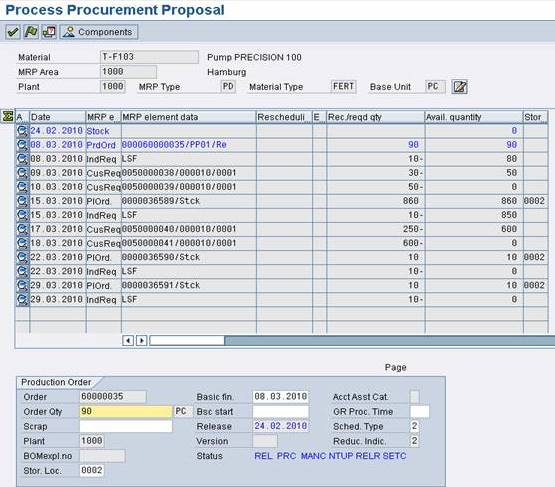In "SAP What is # 9", the Strategy 30 will be illustrated.
You can find the "MRP Strategies" parameter by navigating in the Customizing as follows:
Use IMG path -> Production -> Production Planning -> Demand Management -> Planned Independent Requirement -> Planning Strategy -> Define Strategy
No other settings required other then assignment of the strategy 30 to the MRP 3 views, the forward and backward consumption numbers are still required as consumption will take place.
Periodic lot-sizing rule is recommended as the purpose is the fulfill all requirements in one single order (you shall see this shortly in the following slide).
Here, in the stock requirement list below, you can see 3 groups of requirements (both planned independent requirement and customer requirements) into 3 weeks:
3 planned orders are created for each week fulfilling all the requirements that falls on the same week.
A production order is created for the first planned order of 90.
Production Order completed and now received into stocks below in the S/R list:
A cash sales is created to consume the stocks in warehouse of 5 pieces.
The cash sales of 5 pieces consumed the Planned Independent requirement as below:
CONCLUSION: The Strategy 30 accepts all requirements (both Customer requirement and Planned independent requirement without any consumptions). The total requirements of both shall be considered.
APPLICATION: In this case, usually periodic lot-sizing rule is used to collect all requirement into a single supply order. Useful application when there are big customers and walk-in customers where both demands have to be considered separately.
CAUTION: None.
.
You can find the "MRP Strategies" parameter by navigating in the Customizing as follows:
Use IMG path -> Production -> Production Planning -> Demand Management -> Planned Independent Requirement -> Planning Strategy -> Define Strategy
 |
| From SAP的学习和考试 Learning & Examination |
No other settings required other then assignment of the strategy 30 to the MRP 3 views, the forward and backward consumption numbers are still required as consumption will take place.
 |
| From SAP的学习和考试 Learning & Examination |
Periodic lot-sizing rule is recommended as the purpose is the fulfill all requirements in one single order (you shall see this shortly in the following slide).
 |
| From SAP的学习和考试 Learning & Examination |
Here, in the stock requirement list below, you can see 3 groups of requirements (both planned independent requirement and customer requirements) into 3 weeks:
Week 1 (Mar 08-14) 10+30+50 = 80 for the week
Week 2 (Mar 15-21) 10+250+600 = 860 for the week
Week 3 (Mar 22-28) 10
Week 4 (Mar 29- ) 10
Important: the Planned independent requirements are not consumed by the Sales Orders.
 |
| From SAP的学习和考试 Learning & Examination |
A production order is created for the first planned order of 90.
 |
| From SAP的学习和考试 Learning & Examination |
Production Order completed and now received into stocks below in the S/R list:
 |
| From SAP的学习和考试 Learning & Examination |
The cash sales of 5 pieces consumed the Planned Independent requirement as below:
 |
| From SAP的学习和考试 Learning & Examination |
CONCLUSION: The Strategy 30 accepts all requirements (both Customer requirement and Planned independent requirement without any consumptions). The total requirements of both shall be considered.
APPLICATION: In this case, usually periodic lot-sizing rule is used to collect all requirement into a single supply order. Useful application when there are big customers and walk-in customers where both demands have to be considered separately.
CAUTION: None.
.

No comments:
Post a Comment
Note: Only a member of this blog may post a comment.